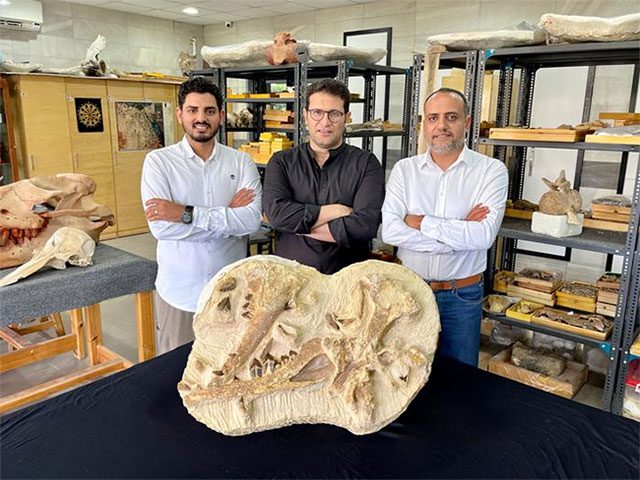A team of Egyptian researchers from Mansoura University, along with international scientists, announced on August 10 the discovery of a previously unknown extinct whale species found in the Fayoum province, naming it Tutcetus rayanensis.
According to a report from Cairo, renowned Egyptian paleontologist Hesham Sallam revealed that this whale species lived 41 million years ago, with fossil specimens discovered in the Valley of Whales area of Fayoum, which at that time was part of an ancient seabed covering much of Egypt and the Western Desert.

Egyptian researchers with the Tutcetus rayanensis original fossil. (Photo: eurekalert).
He further explained that this new whale species belongs to the Basilosauridae family, one of the ancestors of extinct whales that lived during the early phases of aquatic life after transitioning from land to water.
According to Mr. Sallam, Egyptian scientists chose the name Tutcetus rayanensis for the newly discovered whale species due to its blend of Egyptian history and the location where the fossil specimen was found. The term Tutcetus combines “Tut”, the name of the famous young Pharaoh Tutankhamun, and “Cetus”, which means whale in Greek.
The second part of the name, rayanensis, refers to the Wadi El-Rayan Reserve in Fayoum, where this whale species was discovered. Additionally, this name was selected to commemorate the 100th anniversary of the discovery of the tomb of Pharaoh Tutankhamun and to celebrate the upcoming opening of the Grand Egyptian Museum in Giza.
The excavated fossil specimens include a skull, jaw, phalanges, and vertebrae of a small whale from the Basilosauridae family. With an estimated length of about 2.5 meters and a weight of approximately 187 kg, Tutcetus is the smallest known member of the Basilosauridae family to date.
Dr. Sherif Khater, the President of Mansoura University, announced that the research team published their findings in a paper released on August 10 in the scientific journal “Communications Biology”, published by Nature Publishing Group.
He added that this research represents a significant scientific breakthrough for Egyptian paleontologists.


















































